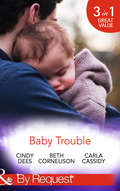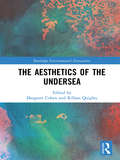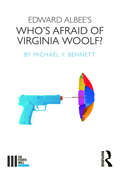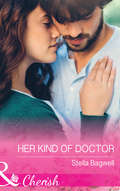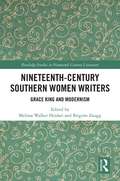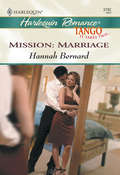- Table View
- List View
Jingle-Bell Baby: Their Christmas Family Miracle / A Princess For Christmas / Jingle-bell Baby (Mills And Boon Cherish Ser. #4133)
by Linda GoodnightOn a dusty roadside Jenna Garwood has just gone into labour. Cowboy Dax Coleman comes to her rescue, delivers her baby and offers Jenna a job! As for Dax, a housekeeper bride was the last thing he expected for Christmas!
Her Happy-Ever-After Family: The Cattleman's Ready-made Family / Miracle In Bellaroo Creek / Patchwork Family In The Outback (Mills And Boon By Request Ser.)
by Barbara Hannay Michelle Douglas Soraya LaneThe Cattleman’s Ready-Made Family Tess Laing moved to Bellaroo Creek with her orphaned niece and nephew for a fresh start.
Snowbound With An Heiress: Snowbound With An Heiress / The Maverick's Snowbound Christmas (montana Mavericks: The Great Family Roundup, Book 5) (Mills And Boon Cherish Ser. #Vol. 4592)
by Jennifer FayeStranded in the snow – together!
Snowbound Bride-to-Be: Snowbound With Her Hero / Snowbound Bride-to-be / Snowbound Cowboy / Snowbound With A Prince / Snowbound Reunion / Snowbound With Mr Right / The Snow-kissed Bride / Snowed In With The Boss (Christmas Ser. #4137)
by Cara ColterEmma White's B&B is Ryder Richardson's only port in a storm. Otherwise he wouldn't be caught dead amongst all the baubles and bells. Yet, snowbound with Emma in her surprisingly sexy Santa hat, Ryder finds a glimmer of a smile reaching his lips. . .
A Trip with the Tycoon (Mills And Boon Cherish Ser. #4121)
by Nicola MarshDetermined to bring her confident, fiery self back, Tamara Rayne is in India on an adventure of a lifetime. Love isn't on her itinerary, so she hardly notices when blast from her past Ethan Brooks boards her train. . .
Winning The Rancher's Heart: The Rancher Next Door Winning The Rancher's Heart (Cowboys in Uniform #5)
by Pamela BrittonA NEW BEGINNING
Baby Trouble: The Spy's Secret Family / Operation Baby Rescue / Cowboy's Triplet Trouble (Mills And Boon By Request Ser. #4)
by Carla Cassidy Beth Cornelison Cindy DeesThe Spy’s Secret Family When tycoon Nick Cass wakes up in a hospital room, he has no memory of the beautiful woman at his side. Yet when Laura Delaney tells him their son has been kidnapped, Nick has no choice but trust her – and rescue their chance at a future.
Thresholds and Boundaries: Liminality in Netherlandish Art (1385-1530) (Visual Culture in Early Modernity)
by Lynn F. JacobsAlthough liminality has been studied by scholars of medieval and seventeenth-century art, the role of the threshold motif in Netherlandish art of the late fourteenth, fifteenth and early sixteenth centuries -- this late medieval/early ‘early modern’ period -- has been much less fully investigated. Thresholds and Boundaries: Liminality in Netherlandish Art (1385-1550) addresses this issue through a focus on key case studies (Sluter's portal of the Chartreuse de Champmol and the calendar pages of the Limbourg Brothers' Très Riches Heures), and on important formats (altarpieces and illuminated manuscripts). Lynn F. Jacobs examines how the visual thresholds established within Netherlandish paintings, sculptures, and manuscript illuminations become sites where artists could address relations between life and death, aristocrat and peasant, holy and profane, and man and God—and where artists could exploit the "betwixt and between" nature of the threshold to communicate, paradoxically, both connections and divisions between these different states and different worlds. Building on literary and anthropological interpretations of liminality, this book demonstrates how the exploration of boundaries in Netherlandish art infused the works with greater meaning. The book's probing of the -- often ignored --meanings of the threshold motif casts new light on key works of Netherlandish art.
The Aesthetics of the Undersea (Routledge Environmental Humanities)
by Margaret Cohen Killian QuigleyAmong global environments, the undersea is unique in the challenges it poses – and the opportunities it affords – for sensation, perception, inquiry, and fantasy. The Aesthetics of the Undersea draws case studies in such potencies from the subaqueous imaginings of Western culture, and from the undersea realities that have inspired them. The chapters explore aesthetic engagements with underwater worlds, and sustain a concern with submarine "sense," in several meanings of that word: when submerged, faculties and fantasies transform, confronting human subjects with their limitations while enlarging the apparent scope of possibility and invention. Terrestrially-established categories and contours shift, metamorphose, or fail altogether to apply. As ocean health acquires an increasing share of the global environmental imaginary, the histories of submarine sense manifest ever-greater importance, and offer resources for documentation as well as creativity. The chapters deal with the sensory, material, and formal provocations of the underwater environment, and consider the consequences of such provocations for aesthetic and epistemological paradigms. Contributors, who hail from the United States, United Kingdom and Australia, include scholars of literature, art, new media, music and history. Cases studies range from baroque and rococo fantasies to the gothic, surrealism, modernism, and contemporary installation art. By juxtaposing early modern and Enlightenment contexts with matters of more recent – and indeed contemporary – importance, The Aesthetics of the Undersea establishes crucial relations among temporally remote entities, which will resonate across the environmental humanities.
Edward Albee's Who's Afraid of Virginia Woolf? (The Fourth Wall)
by Michael Y. BennettEdward Albee’s Who’s Afraid of Virginia Woolf? shocked audiences and critics alike with its assault on decorum. At base though, the play is simply a love story: an examination of a long-wedded life, filled with the hopes, dreams, disappointments, and pain that accompany the passing of many years together. While the ethos of the play is tragicomic, it is the anachronistic, melodramatic secret object—the nonexistent "son"—that upends the audience’s sense of theatrical normalcy. The mean and vulgar bile spewed among the characters hides these elements, making it feel like something entirely "new." As Michael Y. Bennett reveals, the play is the same emperor, just wearing new clothes. In short, it is straight out of the grand tradition of living room drama: Ibsen, Chekhov, Glaspell, Hellmann, O’Neill, Wilder, Miller, Williams, and Albee.
The Early Modern Grotesque: English Sources and Documents 1500-1700 (Routledge Studies in Renaissance Literature and Culture)
by Liam E SemlerThe Early Modern Grotesque: English Sources and Documents 1500-1700 offers readers a large and fully annotated collection of primary source texts addressing the grotesque in the English Renaissance. The sources are arranged chronologically in 120 numbered items with accompanying explanatory Notes. Each Note provides clarification of difficult terms in the source text, locating it in the context of early modern English and Continental discourses on the grotesque. The Notes also direct readers to further English sources and relevant modern scholarship. This volume includes a detailed introduction surveying the vocabulary, form and meaning of the grotesque from its arrival as a word, concept and aesthetic in 16th century England to its early maturity in the 18th century. The Introduction, Items and Notes, complemented by illustrations and a comprehensive bibliography, provide an unprecedented view of the evolving complexity and diversity of the early modern English grotesque. While giving due credit to Wolfgang Kayser and Mikhail Bakhtin as masters of grotesque theory, this ground-breaking book aims to provoke new, evidence-based approaches to understanding the specifically English grotesque. The textual archive from 1500-1700 is a rich and intriguing record that offers much to interested readers and researchers in the fields of literary studies, theatre studies and art history.
South Seas Encounters: Nineteenth-Century Oceania, Britain, and America (The Nineteenth Century Series)
by Richard Fulton Stephen Hancock Peter Hoffenberg Allison PaynterSouth Seas Encounters examines several key types of encounters between the many-faceted worlds of Oceania, Britain and the United States in the formative nineteenth century. The eleven essays collected in this volume focus not only on the effect of the two powerful, industrialized colonial powers on the cultures of the Pacific, but the effect of those cultures on the Western cultural perceptions of themselves and the wider world, including understanding encounters and exchanges in ways which do not underemphasize the agency and consequences for all participating parties. The essays also provide insights into the causes, unfolding, and consequences for both sides of a series of significant ethnographic, political, cultural, scientific, educational, and social encounters. This volume makes a significant contribution to increasing scholarly interest in Oceania’s place in British and American nineteenth-century cultural experiences. South Seas Encounters investigates these significant interactions and how they changed the ways that Oceanic, British, and American cultures reflected on themselves and their place in the wider world.
Outback Baby: Outback Baby (Mills And Boon Cherish Ser. #13)
by Barbara HannayMax Jardine always behaves like a bossy big brother to Gemma Brown. Except for one night five years ago–a night they have never talked about since. But now Gemma is moving into Max's remote Outback home to help him care for a friend's baby…
Just Say Yes (Mills And Boon Cherish Ser.)
by Caroline AndersonMatthew had fallen for Georgia the moment he sat opposite her on a train. Accidentally walking off with the wrong mobile phone gave him the ideal opportunity to see her again.
Bride Of Convenience (Mills And Boon Cherish Ser.)
by Susan FoxStacey Amhearst has no choice but to go ahead with her marriage of convenience to ruggedly sexy Oren McClain. But she is secretly in love with him and is determined to make their marriage work. Will she ever be more to McClain than his wife in name only?
Unexpected Legacy: Once Pregnant, Twice Shy / A Baby For The Doctor (safe Harbor Medical, Book 13) / Her Secret, His Baby (the Colorado Cades, Book 1) (Mills And Boon By Request Ser.)
by Jacqueline Diamond Tanya Michaels Red GarnierThey’ll learn to love again with a new addition to the family! Once Pregnant, Twice Shy by Red Garnier
The Doctor's Valentine Dare: Dr. Forget-me-not The Doctor's Valentine Dare A Valentine For The Veterinarian (Rx for Love #14)
by Cindy KirkHow to win a girl in five dates Josie Campbell says she doesn’t date doctors. But brilliant neurosurgeon Noah Anson has never met a situation he couldn’t control or a woman he couldn’t charm. Winning over the beguiling beauty is a challenge he just can’t resist!
The Maverick's Midnight Proposal: The Maverick's Midnight Proposal (montana Mavericks: The Great Family Roundup, Book 6) / The Magnate's Holiday Proposal (Montana Mavericks: The Great Family Roundup #6)
by Brenda HarlenShould Old Acquaintance Be Forgot?
Her Kind Of Doctor: Claimed By The Wealthy Magnate; Her Kind Of Doctor (Men of the West #37)
by Stella BagwellDoctor Difficult, and the Nurse Who Can Tame Him
Nineteenth-Century Southern Women Writers: Grace King and Modernism (Routledge Studies in Nineteenth Century Literature)
by Melissa Walker Heidari Brigitte ZauggThe essays in this book explore the role of Grace King’s fiction in the movement of American literature from local color and realism to modernism and show that her work exposes a postbellum New Orleans that is fragmented socially, politically, and linguistically. In her introduction, Melissa Walker Heidari examines selections from King’s journals and letters as views into her journey toward a modernist aesthetic—what King describes in one passage as "the continual voyage I made." Sirpa Salenius sees King’s fiction as a challenge to dominant conceptualizations of womanhood and a reaction against female oppression and heteronormativity. In his analysis of "An Affair of the Heart," Ralph J. Poole highlights the rhetoric of excess that reveals a social satire debunking sexual and racial double standards. Ineke Bockting shows the modernist aspects of King’s fiction through a stylistic analysis which explores spatial, temporal, biological, psychological, social, and racial liminalities. Françoise Buisson demonstrates that King’s writing "is inspired by the Southern oral tradition but goes beyond it by taking on a theatrical dimension that can be quite modern and even experimental at times." Kathie Birat claims that it is important to underline King’s relationship to realism, "for the metonymic functioning of space as a signifier for social relations is an important characteristic of the realist novel." Stéphanie Durrans analyzes "The Story of a Day" as an incest narrative and focuses on King’s development of a modernist aesthetics to serve her terrifying investigation into social ills as she probes the inner world of her silent character. Amy Doherty Mohr explores intersections between regionalism and modernism in public and silenced histories, as well as King’s treatment of myth and mobility. Brigitte Zaugg examines in "The Little Convent Girl" King’s presentation of the figure of the double and the issue of language as well as the narrative voice, which, she argues, "definitely inscribes the text, with its understatement, economy and quiet symbolism, in the modernist tradition." Miki Pfeffer closes the collection with an afterword in which she offers excerpts from King’s letters as encouragement for "scholars to seek Grace King as a primary source," arguing that "Grace King’s own words seem best able to dialogue with the critical readings herein." Each of these essays enables us to see King’s place in the construction of modernity; each illuminates the "continual voyage" that King made.
Life-Writing from the Margins in Zimbabwe: Versions and Subversions of Crisis (Routledge Contemporary Africa)
by Oliver NyambiThis book explores the unique contributions of various forms of post-2000 life-writings such as the autobiography, epistles, and biographies, to discourses about the nature and socio-politics of what has become known as the Zimbabwean crisis (c. 2000–2009). Much of what has been written about the Zimbabwean crisis – a decade-long period of unprecedented economic collapse and political upheavals in the southern African country – is strictly discipline-specific and therefore limited to unidimensional modes of theorising the crisis’s many and complex dimensions and dynamics. In this context, this book charts a paradigm shift in hermeneutic and epistemological approaches to comprehending the Zimbabwean crisis. Life-Writing from the Margins in Zimbabwe centres the experiences and memories of ordinary Zimbabweans in pluralizing modes of seeing and knowing the crisis. The book argues that these life-writings present a rich site for encountering versions of the crisis that relate in counter-discursive ways, to the dominant, state-authored narrative of the nation in crisis. Oliver Nyambi’s analysis contributes new ideas to ongoing debates about how cultural texts reflect on the postcoloniality of both power, and experiences and negotiations of power in the context of crisis. This book will be of interest to scholars and students of African literature, Zimbabwean/African studies, postcolonial literature, life-writing and cultural studies.
Traumatic Tales: British Nationhood and National Trauma in Nineteenth-Century Literature (Routledge Studies in Nineteenth Century Literature)
by Lisa KasmerTraumatic Tales: British Nationhood and National Trauma in Nineteenth-Century Literature explores intersections of nationalism and trauma in Romantic and Victorian literature from the emergence of British nationalism through the height of the British Empire. From the national tales of the early nineteenth century to the socially incisive realist novels that emerged later in the century, nationalism is inescapable in this literature, as much current scholarship acknowledges. Nineteenth-century national trauma, however, has only recently begun to be explored. Taking as its starting point the unsettling effects of nationalism, the essays in this collection expose the violence underlying empire-building, particularly in regard to subject identity. National violence—imperialism, colonialism and warfare—necessarily grounds nation-formation in deep-lying trauma. As the essays demonstrate, such fraught nexus are made visible in national tales as well as in political policy, exposed by means of theoretical and historical analyses to reveal psychological, political, social and individual trauma. This exploration of violence in the construction of national ideology in nineteenth-century Britain rethinks our understanding of cultural memory, national identity, imperialism, and colonialism, recent thrusts of Romantic and Victorian study in nineteenth-century literature.
Miss Prim And The Maverick Millionaire: Miss Prim And The Maverick Millionaire (9 To 5, Book 57) / Finding Our Forever (silver Springs, Book 1) (9 to 5 #57)
by Nina SinghIn paradise…with the boss!
His Unexpected Baby Bombshell: His Unexpected Baby Bombshell Falling For The Bridesmaid A Millionaire For Cinderella From Paradise... To Pregnant! (Mills And Boon Cherish Ser.)
by Soraya LaneHis best friend’s baby…
Mission: Marriage (Mills And Boon Cherish Ser.)
by Hannah BernardLea is turning thirty, and the alarm is ringing on her biological clock. But how does a woman with just one ex-boyfriend under her belt learn to find Mr. Right?






